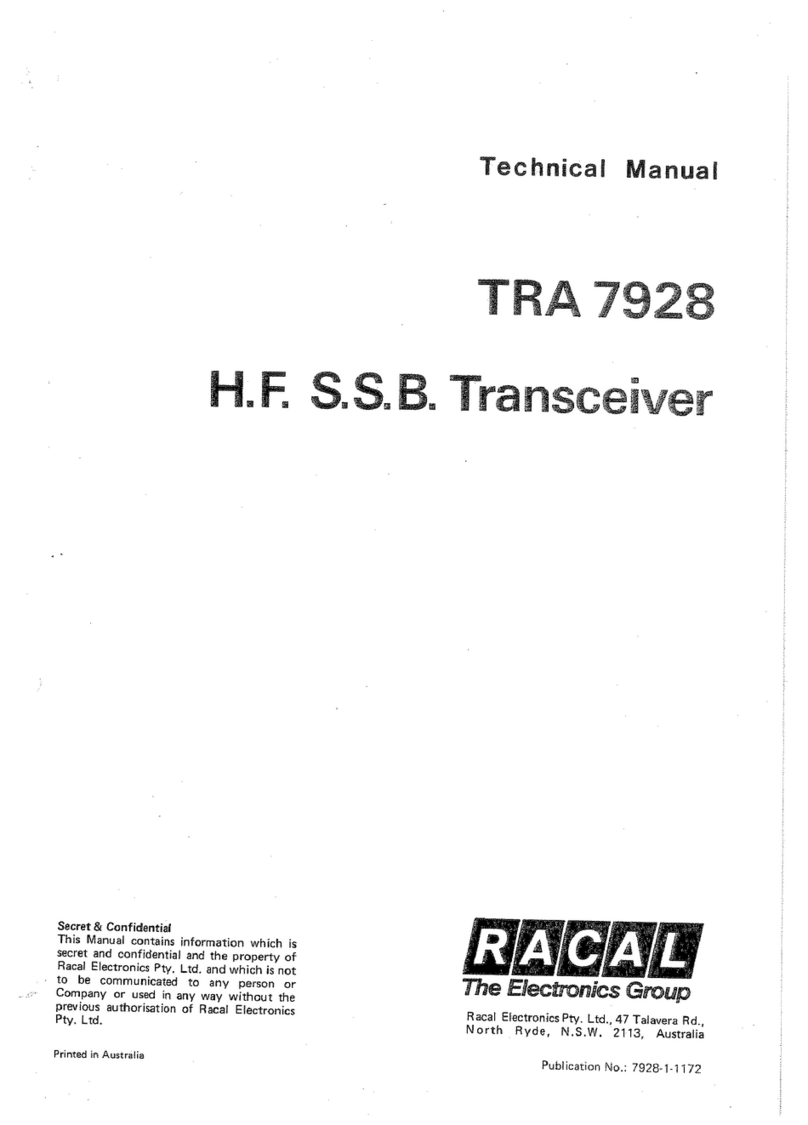
PRC-41 REFERENCE DATA
a. POWER REQUIREMENTS. - 26.5 volts dc+10 percent (equipment will operate with an input voltage as
low as 22 volts dc)or 115 or 230 volts ±10 percent, 50-to-400-cps single phase.
Equipment is normally connected for 115 volts; cable re-fabrication is required for operation from a 230-volt
source. Refer to section 2 of Installation and Operation Technical Manual for Radio Set AN/PRC-41.
Alternatively, battery BB-451/U is used for 10 hours with 1 minute transmit / 9 minutes receive cycle.
b. FREQUENCY DATA.
(1) Range: 225.0 to 399.9 mc.
(2) Channels: 1750 spaced at 100-kc intervals over the range.
(3) Stability: ±15 kc.
(4) Type of frequency control: Crystal.
(5) Number of crystals: 39 crystals.
(6) Type of transmission and reception: A3.
c TRANSMITTER DATA.
(l) Power output: 3 watts average unmodulated power into a 50-ohm load.
(2) Modulation: AM.
(3) Modulation sensitivity: Carbon microphone input of 1.0 volt.
(4) Modulation capability: 80 percent minimum (adjusted to clip between 70 to 90 percent).
(5) Transmitter fidelity: +1, -3 db, 300 to 3500 cps (from 1000-cps reference).
(6) Transmitter distortion: Less than 10 percent with modulation 3 db below clipping level.
(7) Duty cycle: 1-minute transmit, 9-minute receive.
d RECEIVER DATA.
(1) Sensitivity: A signal having an average level of 3 uv modulated 30 percent at 1000 cps produces 7 mw at a signalplus-
noise to noise ratio of 10 db or greater.
(2) Selectivity: 6 db, 47 kc minimum; 60 db. 120 kc maximum.
(3) Images and spurious responses: 70 db
(4) I-f rejection: 80 db down.
(5) Avc characteristics: Output within ±3 db from 10 to 100,000 uv (from 1000-microvolt reference).
(6) Blocking: No blocking for input signals up to, 0.5 volt.
(7) Squelch operation: A change in audio output of at least 10 db is effected by a l-db change in input signal.
(8) Ultimate S+N/N ratio: At least 35 db (measured at 1000 uv).
(9) Audio output: 50 mw into a 300-ohm load with 30- percent modulation, 1000 uv.
(10) Audio fidelity: +1, -3 db from 300 to 3500 cps (from 1000-cps reference).
(11) Audio distortion: Less than 10 percent at 50-mw output.
e. GUARD RECEIVER DATA.
(1) Sensitivity: A signal having an average level of 5 uv into the guard receiver modulated 30 percent at 1000 cps
produces 7 mw at a signal plus-noise to noise ratio of 10 db or greater.
(2) Selectivity: 6 db, 50 kc minimum; 60 db, 200 kc maximum.
(3) Images and spurious responses: 60 db down.
(4) I-f rejection: 80 db down.
(5)
Avc characteristics: Output within ±3 db from 10 to 100,000 uv (from 1000-microvolt reference).
(6) Blocking: No blocking for input signals up to 0.5 volt.
(7) Squelch operation: A change in audio output of at least 10 db is effected by a 1-db change in input si gnal.
(8) Ultimate S+N/N ratio: At least 35 db (measured at 1000 uv).
(9) Audio output: 50 mw into a 300-ohm load with 30-percent modulation, 1000 uv.
(10) Audio fidelity: +1, -3 db from 300 to 3500 cps (from 1000-cps reference).
(11)
Audio distortion: Less than 10 percent at 50-mw output (1000-microvolt input, 1000 cps, 30-percent modulated).
Battery -
BB-451/U 24V - 25Ah Nominal, rechargeable battery
The battery consists of 16 series-connected silver-zinc cells constructed in blocks of four cells each. Nominal open-circuit
voltage of a fully charged cell is 1.86 volts per cell. The minimum voltage per cell under specified load is 1.375 volts at -11
°C (+12F) and above, and 1.250 volts from -10°C to -25°C (+14F to -13°F).
The battery cells will perform according to specifications after charging at a modified constant current of 2.5 amperes
average with voltage cutoff at 2.03 volts. Emergency charging of the cells is possible by charging at a constant potential of
2.03 volts per cell with charge acceptance as follows: a 0.5- charge period replaces 50 percent of the capacity
removed on
previous discharge; a 4-hour charge period replaces 60 percent of the capacity removed on the previous discharge.
All recharging must be with Battery Charger PP-3240/U or its exact replacement.. A plastic sheet for recording charging
history is bonded to the underside of the cover plate. To avoid a long formation and activation period. the BB-451/U is
supplied in a dry charge condition.




























